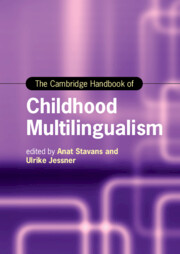Book contents
- The Cambridge Handbook of Childhood Multilingualism
- Cambridge Handbooks in Language and Linguistics
- The Cambridge Handbook of Childhood Multilingualism
- Copyright page
- Contents
- Figures
- Tables
- About the Editors
- Contributors
- Acknowledgments
- Multilingualism Is Not Bilingualism +1: An Introduction
- Part One Becoming and Being a Multilingual Child
- Part Two Cognition and Faculties in Multilinguals
- Part Three Family Language Policy
- Part Four Language(s) and Literacy of Multilingual Children through Schooling
- Part Five Socialization in Childhood Multilingualism
- Part Six Multilingual Children’s Landscape
- 26 Linguistic Landscapes in the Home: Multilingual Children’s Toys, Books and Games
- 27 Linguistic Landscapes in School
- 28 Children’s Perception of Multilingual Landscapes in Interaction
- Subject Index
- Country Index
- Language Index
- References
28 - Children’s Perception of Multilingual Landscapes in Interaction
from Part Six - Multilingual Children’s Landscape
Published online by Cambridge University Press: 18 August 2022
- The Cambridge Handbook of Childhood Multilingualism
- Cambridge Handbooks in Language and Linguistics
- The Cambridge Handbook of Childhood Multilingualism
- Copyright page
- Contents
- Figures
- Tables
- About the Editors
- Contributors
- Acknowledgments
- Multilingualism Is Not Bilingualism +1: An Introduction
- Part One Becoming and Being a Multilingual Child
- Part Two Cognition and Faculties in Multilinguals
- Part Three Family Language Policy
- Part Four Language(s) and Literacy of Multilingual Children through Schooling
- Part Five Socialization in Childhood Multilingualism
- Part Six Multilingual Children’s Landscape
- 26 Linguistic Landscapes in the Home: Multilingual Children’s Toys, Books and Games
- 27 Linguistic Landscapes in School
- 28 Children’s Perception of Multilingual Landscapes in Interaction
- Subject Index
- Country Index
- Language Index
- References
Summary
The present chapter discusses children’s multilingual landscapes and language practices in social interaction and in their play. It presents studies on children of various ages, specifically focusing on how children with multilingual linguistic potentials and various kinds of language proficiency encounter a variety of social settings where multilingual or monolingual discursive practices are used. It discusses main theoretical perspectives on multilingualism, children’s learning and play, and introduces a bottom-up conceptualization of children’s multilingual landscapes. Research highlights how children, in their peer interactions, can use various language ideologies and resources. Children exploit the multilingual character and varieties of languages available in the social context and engage in translanguaging. The chapter reviews research on children’s multilingual peer play, language creativity and metalinguistic awareness. Further, it discusses how children co-create language norms and social order in multilingual peer groups, and how linguistic assets within multilingual families and in multilingual educational environments are invoked and exploited.
Keywords
- Type
- Chapter
- Information
- The Cambridge Handbook of Childhood Multilingualism , pp. 649 - 667Publisher: Cambridge University PressPrint publication year: 2022
References
- 1
- Cited by



